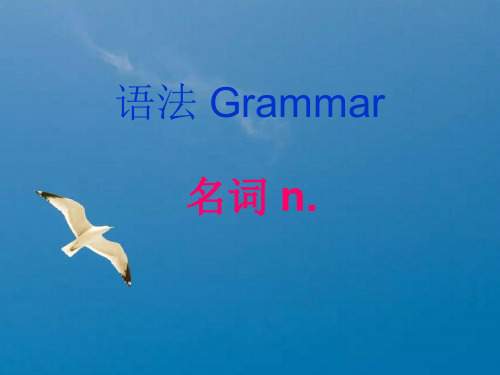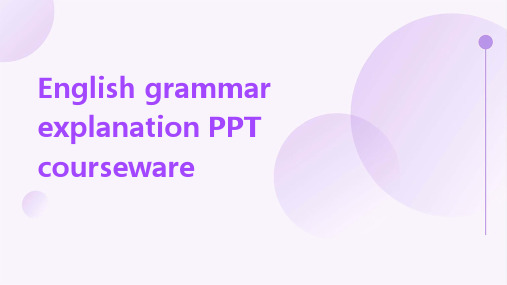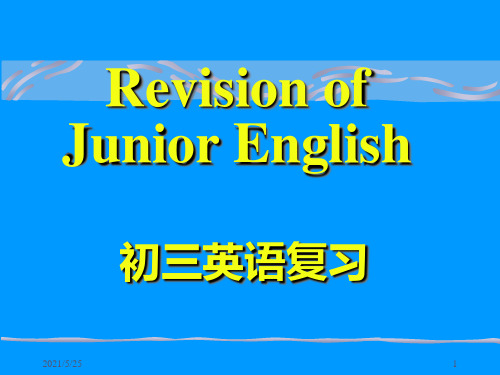初中英语语法专题讲解(400张PPT)
合集下载
初中英语语法复习大全ppt课件

名词一切格:
1) 普通情况加 -’s: children’s books 儿童图书
today’s paper 今天的报纸
(2) 带词尾-s的复数名词只加 (’): girls’ school 女子学校 the Smiths’ car 史密斯家的小汽车
〔3〕留意以下情况: Tom’s and Jim’s rooms 汤姆和吉姆(各自)的房间 Tom and Jim’s room 汤姆和吉姆(共同)的房间
Canadian Canadians German Germans
2)变a为e:
Englishman Englishmen
Frenchman Frenchmen
3〕单复数同形:
Chinese Chinese Japanese Japanese
Swiss Swiss
Exercises~!
1. match _m_a_t_c_h_e_s___ 2. man _m__e_n_____ 3. German _G_e_r_m_a_n_s___ 4. tomato _to__m_a_t_o_e_s_
也就是短语里 面可数名词要 变复数的都变 复数哦~!
*可数名词也可以这样表达量,但要用复数方式:
a box of books five bags of apples
ten kilos of oranges
常用量词总结
a glass of 一玻璃杯 a cup of 一杯 a bottle of 一瓶 a bag of 一包,一袋 a box of 一盒;一箱 a piece of 一张(一片,块) a kilo of 一公斤;一千克 a basket of 一篮 a pair of 一对,一双,一副 a group of 一群,一队,一组
英语语法讲解ppt课件

sentences more vivid and powerful.
05
Sense structure
Subject+predict
The subject+predicate is the basic structure of a simple sentence, expressing a complete idea.
in English
To improve English writing and speaking skills by applying graphical knowledge
To enhance English language comprehension
and reading ability
02
Form
The passive voice is composed of the auxiliary verb be (am/is/are/was/were)+past participle, and the tense is expressed by the change of the be verb.
Subject+predict+object
The subject+predicate+object is an extended structure of a simple sentence, expressing the complete idea and the object involved in the action.
Part of Speech
Noun
01
02
03
Noun
A word that names a person, place, thing, or idea
初中英语语法大全课件

(1)构成名词的后缀常用的有-ence,-(e)r/ -or (从事某事的人),-ese (某地人),-ess (雌性),-ful (一……),-ian (精通……的人),-ist (专业人员),-ment (性质;状态),-ness (性质;状态),-tion(动作;过程)等。例如: differ不同于→difference区别 write写→writer作家 Japan日本→Japanese日本人 act表演→actress女演员 mouth口→mouthful一口 music音乐→musician音乐家 racial种族的----racialist种族主义者
01
合成形容词
02
名词+形容词snow-white雪白的
03
名词+现在分词English-speaking讲英语的
04
名词+to+名词face-to-face面对面的
05
名词+过去分词man-made人造的
06
数词+名词one-way单行的
07
数词+名词+形容词two-year-old两岁的
动词转化为名词
很多动词可以转化为名词,大多意思没有多大的变化(如下①);有时意思有一定变化(如下②);有的与一个动词和不定冠词构成短语,表示一个动作(如下③)。例如:
Let's go out for a walk.我们到外面去散散步吧。
He is a man of strong build.他是一个体格健壮的汉子。
构成副词的常用后缀有-ly (主要用于形容词之后表示方式或程度),-ward(s) (主要用于表示方位的词之后表示方向)。
例如:
angry生气的→angrily生气地
to到→towards朝……,向……
初中英语语法课件ppt

03
Opposite Meanings Adjectives
When using Opposite Meanings Adjectives, place the stronger
one first For example, "big and small."
The Usage of Advantageous
The use of connections
Coordinating Connections
Connections like "and", "but", "or" are used to coordinate two or more independent clauses, e.g., "I like apples, but my brother doesn't"
Subordinating Connections
Connections like "because", "if", "when" are used to introduce sub border clauses, e.g., "I will go to the park because it's sunny today"
Last Simple Tense
Used to express an action that occurred in the past Example: "She walked to school yesterday."
The tense of verbs
Present Continuous Tense
初中英语语法课件ppt

vacation together.
过去将来时的使用:
一、过去将来时表示对于过去某一时间而言将要发生的动 作或存在的状态。 would或was /were going to + V
would可用于各种人称。
二、would +V还可表示过去的习惯动作,在这点上同used to同义。
When we were children, we would/used to go swimming every summer.
e) 用于条件从句“如果……想,设想”(接近if ……want to,或 if ……should) 例:Greater efforts to increase agricultural production must be made if food shortage ____________ avoided. A) is to be B) can be C) will be D) has been
一般现在时的动词形式: 动词原形 1.am;is ;are 2.have,has 3.第三人称单数形式-(e)s
肯定句:I watch television every day.
否定句:I don’t watch television every day.
疑问句:Do you watch television every day.
一般现在时的使用:
1.一般现在时表示总是、通常、习惯 性的动作或状态。
It snows in winter. I watch television every day.
2.用于对客观事实的普遍性的陈述。
Water consists of hydrogen and oxygen. Most animals kill only for food. The world is round.
过去将来时的使用:
一、过去将来时表示对于过去某一时间而言将要发生的动 作或存在的状态。 would或was /were going to + V
would可用于各种人称。
二、would +V还可表示过去的习惯动作,在这点上同used to同义。
When we were children, we would/used to go swimming every summer.
e) 用于条件从句“如果……想,设想”(接近if ……want to,或 if ……should) 例:Greater efforts to increase agricultural production must be made if food shortage ____________ avoided. A) is to be B) can be C) will be D) has been
一般现在时的动词形式: 动词原形 1.am;is ;are 2.have,has 3.第三人称单数形式-(e)s
肯定句:I watch television every day.
否定句:I don’t watch television every day.
疑问句:Do you watch television every day.
一般现在时的使用:
1.一般现在时表示总是、通常、习惯 性的动作或状态。
It snows in winter. I watch television every day.
2.用于对客观事实的普遍性的陈述。
Water consists of hydrogen and oxygen. Most animals kill only for food. The world is round.
初中英语语法大全精品PPT课件

多时,谓语用复数。 如:There is a sheep in the yard.(院子里有只绵羊)
There are some sheep in the yard.(院子里有一些绵羊) 4、maths, news等虽然有s结尾,但不是复数,因此谓语仍用单数: 如:The news is very exciting. (这个消息令人兴奋)
[注解]:
① ‘s还可以表示某人的家或者某个店铺, 如:my aunt’s(我阿姨家), the doctor’s(诊所)
② 两人共有某物时,可以采用 A and B’s 的形 如:Lucy and Lily’s bedroom(露西和丽丽合住的卧室)
Lucy’s and Lily’s bedroom(露西和丽丽分别的卧室)
如果表示整体概念,则谓语用单数形式, 如:Class Three is a very good class.(三班是好班) 如果表示其中的所有成员时,则谓语用复数形式, 如:Class Three have a map of China.(三班有张中国地图) 3、Chinese, Japanese, fish, sheep, people等表示单个时谓语用单数,表示许
如: box, child, orange;
不可数名词{u} 是不可以用简单的数词进行计数的名词。
如:water, news, oil, population, information .
英语可数名词的单复数
1、名词由单数变复数的基本方法如下: ①在单数名词词尾加s。 如:map → maps,boy→ boys,horse→ horses, table→ tables. ②s,o,x ,sh,ch结尾的词加es. 如:class→classes, box→boxes, hero→heroes, dish→dishes,
There are some sheep in the yard.(院子里有一些绵羊) 4、maths, news等虽然有s结尾,但不是复数,因此谓语仍用单数: 如:The news is very exciting. (这个消息令人兴奋)
[注解]:
① ‘s还可以表示某人的家或者某个店铺, 如:my aunt’s(我阿姨家), the doctor’s(诊所)
② 两人共有某物时,可以采用 A and B’s 的形 如:Lucy and Lily’s bedroom(露西和丽丽合住的卧室)
Lucy’s and Lily’s bedroom(露西和丽丽分别的卧室)
如果表示整体概念,则谓语用单数形式, 如:Class Three is a very good class.(三班是好班) 如果表示其中的所有成员时,则谓语用复数形式, 如:Class Three have a map of China.(三班有张中国地图) 3、Chinese, Japanese, fish, sheep, people等表示单个时谓语用单数,表示许
如: box, child, orange;
不可数名词{u} 是不可以用简单的数词进行计数的名词。
如:water, news, oil, population, information .
英语可数名词的单复数
1、名词由单数变复数的基本方法如下: ①在单数名词词尾加s。 如:map → maps,boy→ boys,horse→ horses, table→ tables. ②s,o,x ,sh,ch结尾的词加es. 如:class→classes, box→boxes, hero→heroes, dish→dishes,
初中英语语法专题课件完整版(共983张PPT)

2.不规则变化
构成方法
例词
形式不变 (单复数同形)
sheep-sheep deer-deer Chinese-Chinese Japanese-Japanese
变内部元音字母
foot-feet tooth-teeth goose-geese man-men mouse-mice
词尾加-en/-ren
a group of 一队,一组,一群
②还可用much,little,a little of,a large amount/deal of, no,plenty of等来修饰不可数名词,some,any既可修饰可数名词也可修 饰不可数名词。
much money,plenty of water a little of air some(肯定句): some milk ,some apples any(疑/否):Are there any stamps?I don’t have any money (5)数词-名词-形容词构成的复合形容词,中间的名词不能用
普通名词又可分为下面四类:
1)个体名词:表示单个人或单个事物。 如:gun、kid 、book。 2)集体名词:表示一群人或一些事物组成的集合体。 如:family。
3)物质名词:表示无法分为个体的物质、材料、食品、饮料、液体、气体、 金属等名称的名词,
如:pork、wood、bread、water、air。 4)抽象名词:表示动作、状态、品质、感情等抽象概念及学科、疾病。 如:work 。Hunger、honesty 、love、Chinese、success、HIV。 个体名词和集体名词可以用数目来计算,称为可数名词。
f,fe 为v,再加 -es
shelf-shelves thief-thieves
初中英语语法大全-PPT

9.(2011·上海)These natural disasters have warned us that everyone should start to protect the ________immediately. A.amusement B.development C.environment D.government 【解析】本题考查名词词义辨析。amusement“娱乐”;development“发 展”;environment“环境”;government“政府”。句意为“这些自然 灾害已经告诫我们每个人应立刻开始保护环境。” 【答案】C
【答案】A
6.(2011·南京)—Mrs Black, could you give me some advice on how to write an application letter? —With pleasure.Remember that the letter should be written in the formal ________. A.value B.style C.effect D.mood 【解析】本题考查名词词义辨析。value“益处,价值”;style“风格, 文体”;effect“影响,效果”;mood“情绪,心情”。由语境知“写申 请信应用正式文体”。 【答案】B
10.(2011·黄冈)—Mrs.Wang was sent to teach English in a poor mountain village last year. —She said she would never forget some pleasant ________ while working there. A.experiments B.expressions C.experiences D.emotions 【解析】本题考查名词词义辨析。experiment“实验”;expression“表 达”;experience“经历”;emotion“感情”。空格所在句的句意为“ 她说她永远也不会忘记在那工作时的一些美好的经历。”故选C。 【答案】C
初中英语语法PPT课件

初中英语语法总结
初中语法分类
• 初中语法项目分类:(共8类) • 一般分类 • 1、一般现在时 • 2、一般过去时 • 3、一般将来时 • 4、现在进行时 • 5、现在完成(进行)时 • 6、过去进行时 • 7、过去完成时 • 8、过去将来时
一般现在时
• 构成: • 动词用原形 • 三人称单数-s / es
D. were; have for • 2. Could you tell me what time the plane ______? • A. left B. leaves C. leaved D. was leaving • 3. One of us ______band last month. • A. leaves B. leave C. leaved D. left
• 构成: • 动词用过去时 • Be—was/ were
• 用法: • 表过去某个、段时间内动作及状态
• 象征词: • ago/just now /In1998 last/yesterday 等
一般过去时
• 规则变化: • 一般/去e 双写/辅+y结尾-ied • 不规则变化: • go-went come-came • do-did leave-left等
过去将来时
• 构成: • would + V 原形 • 多用宾语从句中
• 用法: • 过去看来将要发生的动作或状态
• 象征词: • He said that he… the next day .
过去将来时
• 例句: • He said that he would come here the next
• 3. Jim __________ (jump) on the bus as it ____ ______ (move) away.
初中语法分类
• 初中语法项目分类:(共8类) • 一般分类 • 1、一般现在时 • 2、一般过去时 • 3、一般将来时 • 4、现在进行时 • 5、现在完成(进行)时 • 6、过去进行时 • 7、过去完成时 • 8、过去将来时
一般现在时
• 构成: • 动词用原形 • 三人称单数-s / es
D. were; have for • 2. Could you tell me what time the plane ______? • A. left B. leaves C. leaved D. was leaving • 3. One of us ______band last month. • A. leaves B. leave C. leaved D. left
• 构成: • 动词用过去时 • Be—was/ were
• 用法: • 表过去某个、段时间内动作及状态
• 象征词: • ago/just now /In1998 last/yesterday 等
一般过去时
• 规则变化: • 一般/去e 双写/辅+y结尾-ied • 不规则变化: • go-went come-came • do-did leave-left等
过去将来时
• 构成: • would + V 原形 • 多用宾语从句中
• 用法: • 过去看来将要发生的动作或状态
• 象征词: • He said that he… the next day .
过去将来时
• 例句: • He said that he would come here the next
• 3. Jim __________ (jump) on the bus as it ____ ______ (move) away.
初中英语语法大全PPT优秀课件

7)掌握几种同义句转换
1. He is taller than any other student in his class.
= He is taller than the other students in his class.
= He is taller than any of the other students in his class.
* They haven’t come back yet.
★ such 修饰名词 so 修饰形容词、副词
*I have never seen such an
interesting film.
*This box is so heavy that I can’t
carry it.
2021/5/25
3
★ alone(单独、独自)作表语=by oneself lonely(孤独的)可作表语、定语
2021/5/25
28
用词的适当形式填空
1 He works very __h_a_r_d_____. He _h__a_r_d_l_y___
has a rest on Sunday. (hard)
2 __L_u_c_k__il_y__, he didn’t fail in the exam.(luck)
A. the latest B. later
C. early
D. as late
(B )2 The more we looked at the picture, ____.
A. we like it less B. the less we liked it
C. better we liked it D. it looked better
初中英语基础语法完整ppt课件

初中英语基础语法
最新课件
1
名词、形容词、代词、 数词、冠词、动词、 副词、介词、连词、感叹词
最新课件
2
名词(n.): 表示人、事物、地点或抽象概念 的名称。
如:boy, morning, bag, ball, class, orange.
最新课件
3
英语名词可分为专有名词和普通名词两大类。
1)专有名词:是国名、地名、人名、团体、机构等的专用 名称。
chief-chiefs, proof-proofs, roof-roofs
hero-heroes, potato-potatoes, tomato-tomatoes, piano-pianos, radio-radios, zoo-zoos
最新课件
18
综合挑战,你敢接吗?
plane s
brushes churches pianos
示范:cat ---- cats 答题者说出名词复数后要拼写正 确,否则不计分
最新课件
21
需要记分员和主持人一名
要求:
1.记分员和主持人要本着公平公正的原则,不得有 人和私心,其他组成员发现有不公平现象,经大家 同意,给记分员和主持人所在组减分。
2.记分员和主持人若想参与游戏,可与本组人员交 换
最新课件
potato-potatoes tomato-tomatoes
radio-radios,
zoo-zoos
* piano-pianos photo-photos
最新课件
17
一般情况在词尾加-s
以s, x, ch, sh结尾的名词 后加-es 以辅音字母加y结尾的名 词,变y为i加-es
以-f或-fe结尾的名词一般 变-f或-fe为v再加-es
最新课件
1
名词、形容词、代词、 数词、冠词、动词、 副词、介词、连词、感叹词
最新课件
2
名词(n.): 表示人、事物、地点或抽象概念 的名称。
如:boy, morning, bag, ball, class, orange.
最新课件
3
英语名词可分为专有名词和普通名词两大类。
1)专有名词:是国名、地名、人名、团体、机构等的专用 名称。
chief-chiefs, proof-proofs, roof-roofs
hero-heroes, potato-potatoes, tomato-tomatoes, piano-pianos, radio-radios, zoo-zoos
最新课件
18
综合挑战,你敢接吗?
plane s
brushes churches pianos
示范:cat ---- cats 答题者说出名词复数后要拼写正 确,否则不计分
最新课件
21
需要记分员和主持人一名
要求:
1.记分员和主持人要本着公平公正的原则,不得有 人和私心,其他组成员发现有不公平现象,经大家 同意,给记分员和主持人所在组减分。
2.记分员和主持人若想参与游戏,可与本组人员交 换
最新课件
potato-potatoes tomato-tomatoes
radio-radios,
zoo-zoos
* piano-pianos photo-photos
最新课件
17
一般情况在词尾加-s
以s, x, ch, sh结尾的名词 后加-es 以辅音字母加y结尾的名 词,变y为i加-es
以-f或-fe结尾的名词一般 变-f或-fe为v再加-es
最新初中英语语法知识汇总PPT精品课件

(3) It is + 不及物动词 + 从句 It seems that… It happened that… It appears that…
(4) It + 过去分词 + 从句 It is reported that… It has been proved that… It is said that…
表语从句在复合句中作表语的名词性从句,放在系动 词之后,一般结构是“主语+连系动词+表语从句”。可 以接表语从句的连系动词有be, look, remain, seem等。 引导表语从句的that常可省略(shěnglüè)。另外,常用的 还有the reason is that… 和It is because 等结构。例如: 1) The question is whether we can make good preparation in such a short time. 2) This is why we can’t get the support of the people. 3) But the fact remains that we are behind the other classes. 4) The reason he is late for school 第十页,共14页。 is that he missed
D. we should develop
2.It is necessary that ______ by the end of the week.
A. we got everything ready B. we have got everything ready
×√ (5)含主语从句的复合句是疑问句时,主语从句不可提前。例如: Is it likely that it will rain in the evening? Is that will rain in the evening likely? √ ×
(4) It + 过去分词 + 从句 It is reported that… It has been proved that… It is said that…
表语从句在复合句中作表语的名词性从句,放在系动 词之后,一般结构是“主语+连系动词+表语从句”。可 以接表语从句的连系动词有be, look, remain, seem等。 引导表语从句的that常可省略(shěnglüè)。另外,常用的 还有the reason is that… 和It is because 等结构。例如: 1) The question is whether we can make good preparation in such a short time. 2) This is why we can’t get the support of the people. 3) But the fact remains that we are behind the other classes. 4) The reason he is late for school 第十页,共14页。 is that he missed
D. we should develop
2.It is necessary that ______ by the end of the week.
A. we got everything ready B. we have got everything ready
×√ (5)含主语从句的复合句是疑问句时,主语从句不可提前。例如: Is it likely that it will rain in the evening? Is that will rain in the evening likely? √ ×
初中英语语法PPT课件

• 跟不定式作宾补的动词是: • (1)劝教命请叫:advise,teach,order, command,ask,tell。 • (2)允许又警告:allow,permit,warn。 • (3)使役帮想望:cause,let,have, make,help,get,wish,want,expect。 • (4)知觉全部上:feel,hear,watch, see,observe,notice。
初中英语语法
第一章 词类与句子的
• 1.陈述句变疑问句口诀: • “是,情,助”,移向前,主语让步往后缩,现 在过去do来变,谓语只把原形现,最后莫忘问号 点。 • 2.对划线部分提问的程序: • 一代(用疑问词代替划线部分) • 二移(把疑问词移至句首) • 三倒(颠倒主谓语,但对主语提问时除外) • 四抄(照抄其他部分)
• • • • •
• (3)当人称代词在句子中作宾语随后又有-ing作 补语,人称代词只能用宾语不用属格。 • They caught him cheating on the exam.(not his) 他们抓着他在考试中作弊。 • (4)在anyone/no one but之后可用第一二人称 反身代词作主语,却不用第三人称反身代词。 • Anyone but yourself would have noticed the change.除你本人外大家都注意到了变化。 • Nobody but myself noticed the change.除我自己 再没人注意到变化。 • *Nobody but himself noticed the change. • 应该说: • Nobody but he himself noticed the change.除他 自己再没人注意到变化。
「初中英语语法全套PPT课件」

「初中英语语法全套PPT 课件」
这是一份全面的初中英语语法 PPT 课件,以深入浅出的方式全面介绍英语语 法的各个方面,让初学者轻松入门。
为什么英语语法很重要
表能力
良好的语法可以使你的文章更加流畅且更容易被 理解。
学术发展
良好的语法是学术发展不可或缺的基础。
口语表现
正确的语法可以帮助你在口语交际中更准确和流 利地表达自己的想法。
2 失去信任
糟糕的语法会给人留下一个 不专业或不可靠的印象,从 而影响你的事业。
3 低效率
纠正错误的语法需要更多的时间和精力,可能会降低你的工作效率。
提高英语语法的方法
头脑风暴
记录语法问题和想法的笔记簿。
阅读
阅读具有良好英语语法的文章。
练习
通过写作和报告练习语言表达能力。
语言交流
尝试在普通对话中使用所学的语法规则来加强记忆 和熟练度。
总结及要点
掌握词汇和句法的基础知识 避免语法错误的影响
熟悉主要的语法项目 通过多种方式去提高你的英语语法水平
高考和托福考试
英语语法是高考和托福考试的重要部分,正确运 用语法可以帮助你获得更高的分数。
词汇和句法的基础知识
字典
需要了解各种单词的含义和用法。
句法结构
句子结构和语序的掌握是学习英语语法的关键。
词汇卡片
通过使用词汇卡片来加强词汇的记忆。
语法书籍
使用一本好的语法书籍来更深入地学习语法规则和 语法知识。
时态
1
过去时
用于描述过去的事件或状态
2
现在时
用于描述目前正在发生的事情或状态
3
将来时
用于描述未来将要发生的事情或状态
数量词、冠词、介词、代词和名词
这是一份全面的初中英语语法 PPT 课件,以深入浅出的方式全面介绍英语语 法的各个方面,让初学者轻松入门。
为什么英语语法很重要
表能力
良好的语法可以使你的文章更加流畅且更容易被 理解。
学术发展
良好的语法是学术发展不可或缺的基础。
口语表现
正确的语法可以帮助你在口语交际中更准确和流 利地表达自己的想法。
2 失去信任
糟糕的语法会给人留下一个 不专业或不可靠的印象,从 而影响你的事业。
3 低效率
纠正错误的语法需要更多的时间和精力,可能会降低你的工作效率。
提高英语语法的方法
头脑风暴
记录语法问题和想法的笔记簿。
阅读
阅读具有良好英语语法的文章。
练习
通过写作和报告练习语言表达能力。
语言交流
尝试在普通对话中使用所学的语法规则来加强记忆 和熟练度。
总结及要点
掌握词汇和句法的基础知识 避免语法错误的影响
熟悉主要的语法项目 通过多种方式去提高你的英语语法水平
高考和托福考试
英语语法是高考和托福考试的重要部分,正确运 用语法可以帮助你获得更高的分数。
词汇和句法的基础知识
字典
需要了解各种单词的含义和用法。
句法结构
句子结构和语序的掌握是学习英语语法的关键。
词汇卡片
通过使用词汇卡片来加强词汇的记忆。
语法书籍
使用一本好的语法书籍来更深入地学习语法规则和 语法知识。
时态
1
过去时
用于描述过去的事件或状态
2
现在时
用于描述目前正在发生的事情或状态
3
将来时
用于描述未来将要发生的事情或状态
数量词、冠词、介词、代词和名词
- 1、下载文档前请自行甄别文档内容的完整性,平台不提供额外的编辑、内容补充、找答案等附加服务。
- 2、"仅部分预览"的文档,不可在线预览部分如存在完整性等问题,可反馈申请退款(可完整预览的文档不适用该条件!)。
- 3、如文档侵犯您的权益,请联系客服反馈,我们会尽快为您处理(人工客服工作时间:9:00-18:30)。
4.与单数名词连用表示一类事物,如:the dollar“美元”;或与形容 词或分词连用表示一类人,如:the rich“富人”;the living“生者”。
5.用在序数词和形容词最高级及形容词only, very, same 等前面。 Where do you live?I live on the second floor. 你住在哪?我住在二层。 That's the very thing I've been looking for. 那正是我要找的东西。
The dog is an honest animal to human beings. 狗是对人类忠诚的动物。
3.用于表示时间、速度、价格等意义的名词前,有“每一”之意,相当于every。 —How much is the meat? 肉多少钱? —It's eight yuan a kilo. 每公斤8块钱。 4.泛指某人或某物。 A boy is looking at you. 一个男孩在看你。 5.用在某些物质名词或抽象名词前,表示“一份,一场”等。 Would you like a drink? 你想喝杯饮料吗? 6.用于可视为一体的两个名词前。 a knifeittle/few/bit,in a hurry,catch a cold,have a good time,have a rest, after a while,in a word
8.用于固定结构后,如: quite/half/rather/many/such+a(an)+名词 He's quite a famous artist. 他是个很有名的艺术家。
11.用在惯用语中。 in the morning/afternoon/evening,in the end,by the way,at the age of,at the moment等。 12.用于方向名词或表示江河、山脉、海峡等专有地理名称前。 in the southeast of,at the back of,the Red Sea 13.用在逢十的复数名词前,表示年代,也指人的大约岁数。 The young girl is in the twenties. 这个年轻的女孩大约二十几岁。 The war broke out in the forties. 这场战争发生在40年代。
6.与复数名词连用,指整个群体。 They are the teachers of this school.(指全体教师) 他们是这所学校的全体老师。 They are teachers of this school.(指部分教师) 他们是这所学校的老师。
7.表示所有,相当于物主代词,用在表示身体部位的名词前。 She caught me by the arm.她抓住了我的手臂。
注意: 1.不定冠词a/an的区别 a用在以辅音音素开头的单词前,an用在以元音音素开头的单词前, 判断一个单词是元音开头还是辅音开头,要根据其读音,而不是根据首字 母。如: an honest boy,a useful book There is an “f” in the word “five”. 在“five”中有字母“f”。 我们可以这样来记忆:不见元音不加an,不看字母看发音。 2.以u开头的单词,要注意区别。如: an umbrella,an unusual story,an unhappy boy,a university,a useful book
8.用在某些由普通名词构成的国家名称、机关团体、阶级等专有名词前。 the People’s Republic of China 中华人民共和国 the United States 美国
9.用在表示西洋乐器的名词之前,但中国乐器前不加the。 play the piano 弹钢琴
10.用在姓氏的复数名词之前,表示“一家人”或“夫妇二人”。 the Greens 格林一家人(或格林夫妇)
专题一 冠词
an apple on the tree
the apple on the table
什么是冠词?
一、冠词的定义 冠词是虚词,本身不能单独使用,也没有词义,它用在
名词前面,帮助指明名词的含义。
泛指单一,每一,任一事物 an指类别 单数可数
冠
名 定 冠词要 词前用一the特 指上 被说世文 限话上提 制双独到 性方一过 修所无的 饰默二人 语认的或 所的事事 限人物物 定或的事人物或事物
(二)不定冠词的用法 1.不定冠词用来表示“一”这个数量,其意思和“one”差不多。 —What can I do for you, madam?要点什么,女士? —I want an orange skirt for my daughter. 我想为我女儿买条橘黄色的裙子。
2.泛指人或事物的某一类,尤其是作表语时要用a+单数名词,而 不用the+单数名词。
(三)零冠词的用法 1.在专有名词前不加冠词,如国名、省名、城市名、街名、公园名等。 Sanya is in Hainan Province. 三亚在海南省。 2.一日三餐、球类运动和学科名词前不加冠词。 They like playing football after school. 他们喜欢放学后踢足球。 I like English very much. 我非常喜欢英语。 3.表示节日、季节、星期、月份的名词前不加冠词,但若特指某年的 某月、某季节,则需要在月份、季节前加the。 Today is Friday /July 14th. 今天是星期五/7月14日。
指类别
词
复数可数 名词,不可
t特he指上 被说文 限话提 制双到 性方的 修所人 饰默或 语认事 所的物 限人定或的事人物或事物
数名词前
零冠词泛 指指类的别人或事物
(一)定冠词的用法 定冠词the与指示代词this,that同源,有“那(这)个”的意思,但较弱, 可以和一个名词连用,来表示某个或某些特定的人或东西。 1.特指双方都明白的人或物。 Take the medicine.把药吃了。 2.上文提到过的人或物。 He bought a house. I've been to the house. 他买了幢房子。我去过那幢房子。 3.指世上独一无二的事物,如:the sun;或用于对两个人或事物比 较时起特指作用的比较级前。 He is the taller of the two boys.两个男孩中他较高点。
